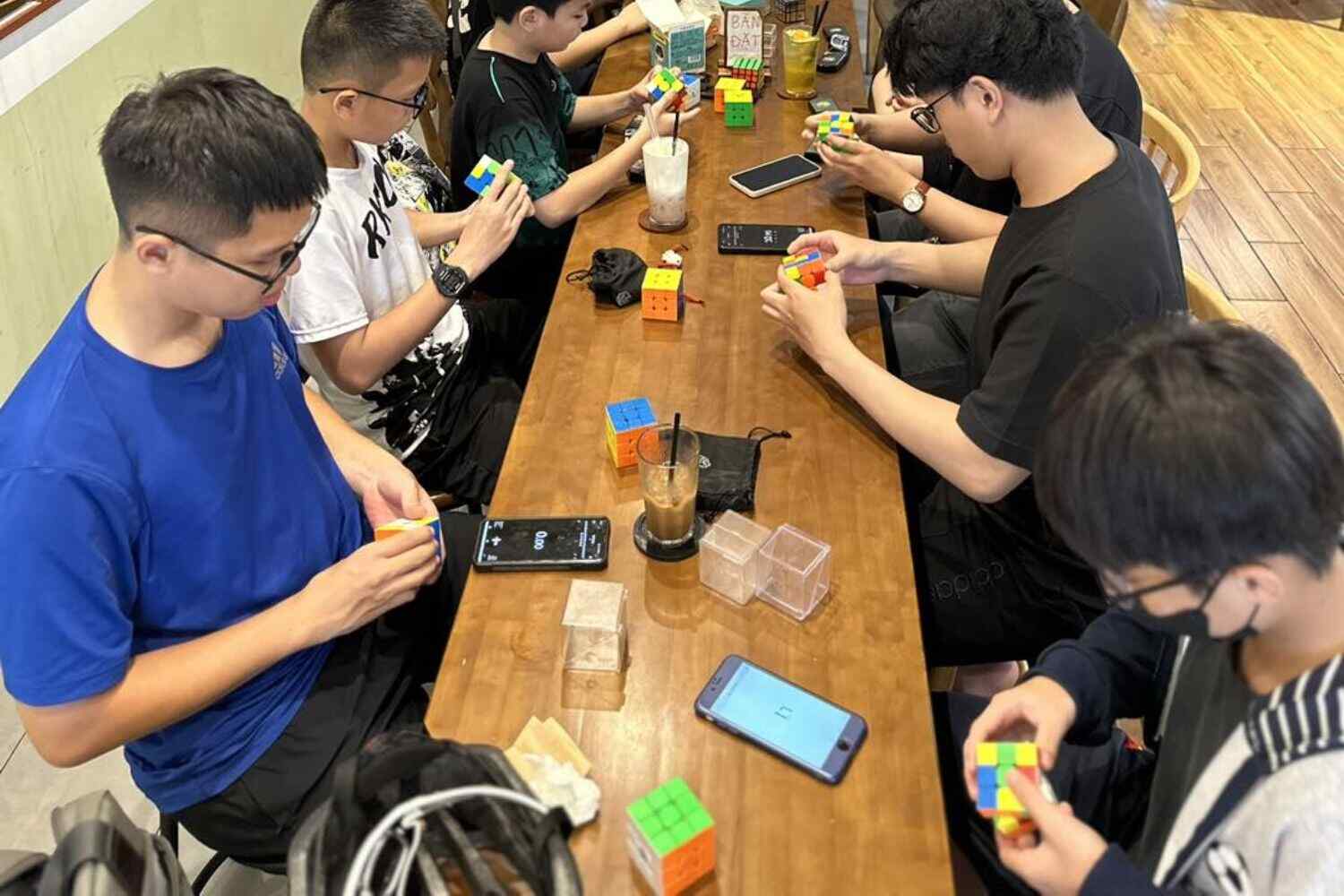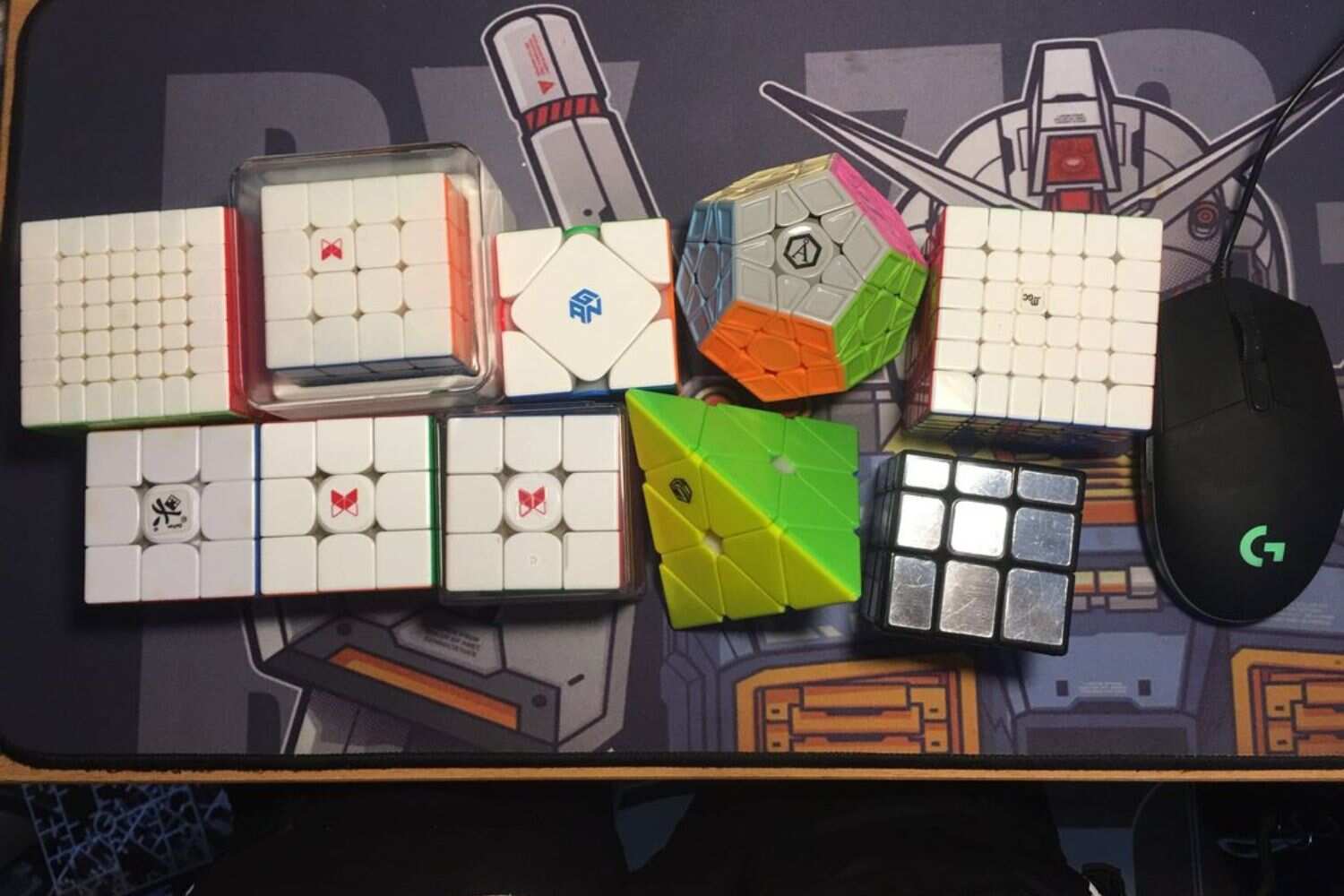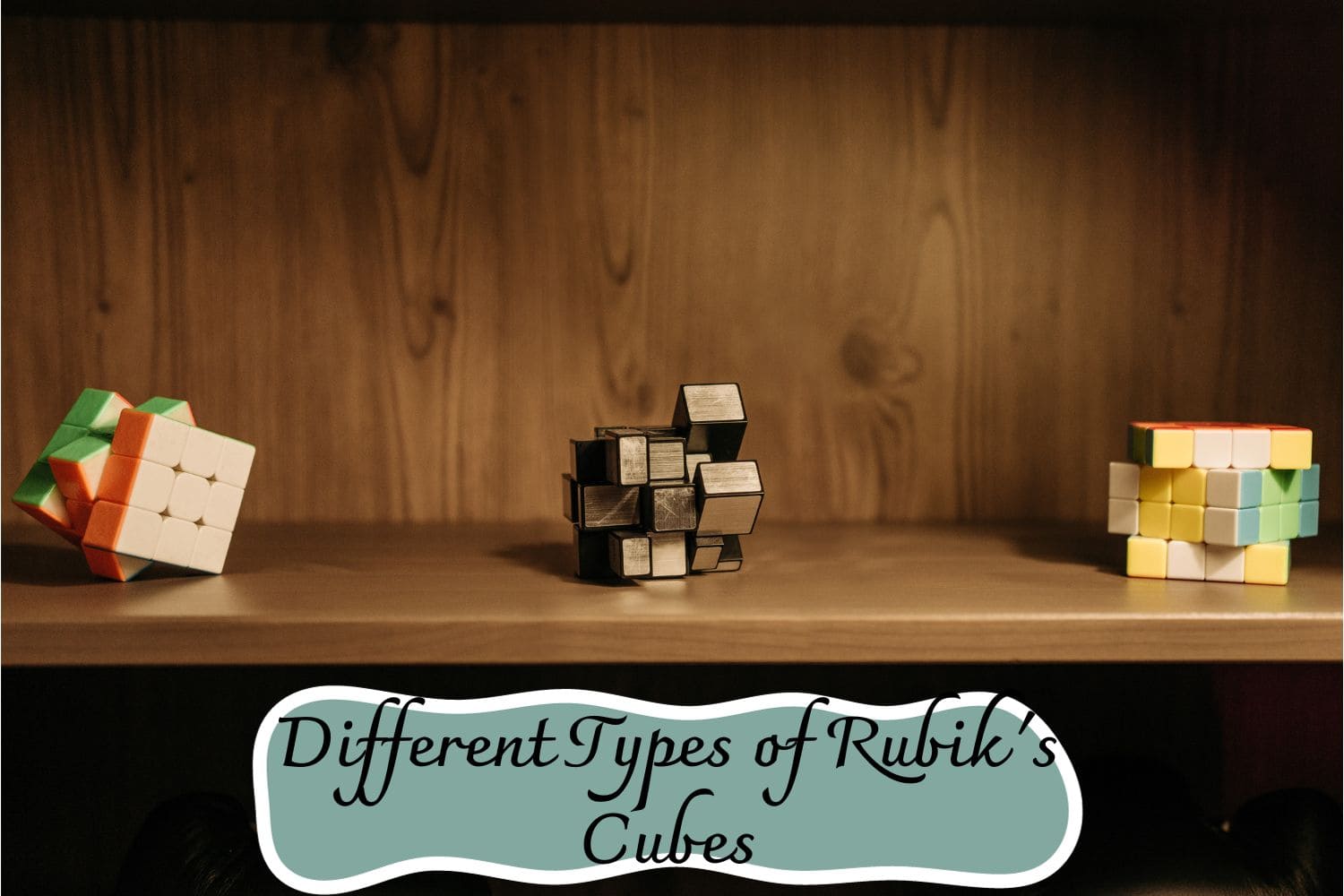Do you have a puzzle appetite that needs satisfying? We’ve got you covered with this guide to the different types of Rubik’s cubes.
A Comprehensive Guide to Different Types of Rubik’s Cubes
Are you constantly on the hunt for a new challenge? Look no further than the Rubik’s Cube! This classic puzzle has captivated minds since head of architecture and design Ernő Rubik crafted it in 1974.
With its unique 3-D structure, colorful cubes, irreproachable game mechanics, and near-endless variations from basic beginnings – many believe it to be the world’s most successful toy.
So if you’re looking for something to improve your problem-solving skills or curiosity which will never get boring – join us as we dive into different types of Rubik’s Cubes from around the globe.
History of Rubik’s Cube
The Rubik’s Cube was initially designed by Hungarian sculptor and professor of architecture Ernő Rubik in 1974. Originally called the “Magic Cube”, it was renamed “Rubik’s Cube” when it gained popularity in the Western world.
Rubik himself stated that he created the puzzle to teach his students about spatial relationships and help them understand 3-D objects. Little did he know that it would become an international sensation loved by people of all ages.
12 Different Types of Rubik’s Cubes
#1 Standard 3×3 Cube

Discover the original and most well-known version of the Rubik’s Cube – the 3×3 Rubik’s Cube. This is the puzzle that comes to mind when you hear the name, and it offers simplicity and manageability.
The standard Rubik’s Cube has six faces, each with nine colored squares that can be rotated independently. The objective is to scramble the colors and then solve the puzzle so that each face only has one color.
This classic version of the puzzle is still the most popular and can be found in homes, schools, and competitions worldwide.
With just six sides and nine squares on each side, the 3×3 Rubik’s Cube is the perfect size for beginners to get started. Its easy manipulation makes it an ideal choice for those new to the puzzle, as well as for seasoned solvers.
What sets the 3×3 Rubik’s Cube apart is its versatility. Solve it using algorithms or rely on your intuition – the choice is yours. This personal touch adds to the appeal of the puzzle, allowing you to make it your own.
Be amazed by the record-breaking 3.47 seconds it takes to solve the Rubik’s Cube. While it may be challenging, the satisfaction of solving the 3×3 Rubik’s Cube is a reward worth pursuing. With practice, anyone can conquer this classic puzzle and experience the joy of a job well done.
#2 Mini Cube
Known as the “Pocket Cube” or “Mini Cube”, this 2×2 version of the original Rubik’s Cube was first created by Eastsheen in 2002. It has smaller dimensions and fewer squares, making it a great option for on-the-go fun.
The Mini Cube has eight smaller faces instead of six, each with four colored squares. With four sides, each consisting of four squares of a single color, the puzzle aims to scramble the cube and then restore it to its original state with each side displaying one solid color.
Despite its size, this version still offers a challenging puzzle experience and requires strategic moves to solve.
As the smallest Rubik’s Cube is available, the Mini Cube is perfect for travel or those looking for a quick challenge. Its compact size makes it easy to carry and its straightforward mechanics make it ideal for beginners.
One of the main benefits of the 2×2 Rubik’s Cube is its compact size, making it an ideal choice for those seeking a portable puzzle. Its smaller dimensions also make it easier to manipulate, resulting in faster solving times and less frustration for beginners.
Despite its smaller size, the 2×2 Rubik’s Cube still offers a challenging and fulfilling experience. While it is considered easier than the 3×3 Rubik’s Cube, it requires a certain level of skill and patience to solve.
This makes it an excellent stepping stone for those aspiring to tackle the larger version of the puzzle.
Another advantage of the 2×2 Rubik’s Cube is that many of the same techniques and algorithms used for solving the 3×3 Rubik’s Cube can be applied.
This enables solvers to transfer their knowledge and skills between the two puzzles, making it a great option for those looking to improve their problem-solving abilities.
#3 The Master Cubes

For those who have mastered the standard Rubik’s Cube and are looking for a new challenge, the Master Cubes offer a more complex and challenging experience.
The Master Cube series includes the 4×4 Rubik’s Revenge, the 5×5 Professor’s Cube, and the 6×6 V-Cube. These puzzles feature more pieces and layers than the standard Rubik’s Cube, requiring advanced problem-solving skills and a deeper understanding of cube theory.
Each Master Cube has its unique solving methods and algorithms, making it a favorite among speedcubers who enjoy pushing their solving abilities to the limit.
The current world record for the 4×4 Rubik’s Revenge is held by Max Park from the United States, with a time of just 18.42 seconds. The 5×5 Professor’s Cube record is currently held by Australian Feliks Zemdegs, with an impressive solve time of 37.83 seconds.
And for the 6×6 V-Cube, Yusheng Du from China holds the record at an astounding 1 minute and 40.86 seconds.
With their larger size and increased complexity, the Master Cubes offer a new level of challenge for puzzle enthusiasts.
#4 Skewb

The Skewb is a unique twist on the classic Rubik’s Cube, introduced in 1982 by Tony Durham. It features a shape-shifting mechanism that adds an extra layer of difficulty and intrigue to the puzzle.
The Skweb puzzle is a fascinating modification of the Pyraminx, operating on the same four axes mechanism. With its 8 corners and 6 square centerpieces, this puzzle offers a unique twist on the classic design.
Upon disassembling the Skweb, you’ll discover that the cores remain consistent with the Pyraminx structure. Surprisingly, the four corners are the centers, while the remaining four pieces serve as the edges.
The objective is to rotate the faces and restore them so that each face displays a solid color.
While it may seem similar to other Rubik’s Cubes, the Skewb offers a new set of challenges with its shape-shifting design. Solving this puzzle requires both logical thinking and spatial awareness, making it an excellent exercise for your brain.
The Skewb has also inspired other variations, such as the Master Skewb and Skewb Diamond, further challenging puzzle enthusiasts. Its unique design and solving methods make it a must-have for any Rubik’s Cube collection.
#5 The Pyraminx

The Pyraminx is a twisty puzzle in the shape of a pyramid, invented by Uwe Mèffert in 1970. It consists of four triangular sides which can be rotated to scramble the colors, and then restored to have each side display one solid color.
One of the main appeals of the Pyraminx is its unique shape and appearance. Its pyramid structure sets it apart from other Rubik’s Cube variants, making it a popular choice for collectors and puzzle enthusiasts alike.
Don’t be discouraged by its appearance – the Pyraminx is designed to be straightforward and enjoyable for everyone. If you’re new to Rubik’s Cube-style puzzles, this is a fantastic starting point.
With only four layers to solve, the Pyraminx may seem easier than its cubic counterparts. However, its unique shape presents a different set of challenges and requires different solving techniques.
One notable feature of the Pyraminx is its corner pieces – unlike the traditional cube, these pieces can be rotated 360 degrees, adding a new level of complexity to the puzzle.
What sets the Pyraminx apart is its fascinating turning mechanism. Unlike the traditional Rubik’s Cube, which requires rotating entire sides, the Pyraminx allows you to rotate individual triangular pieces.
This adds an exciting challenge to the solving process, making it an ideal choice for experienced solvers seeking something fresh and stimulating.
The Pyraminx also has multiple solutions depending on how it is scrambled. This makes it a great choice for those who enjoy experimenting with different solving techniques and discovering new patterns and algorithms.
While not as popular as the standard Rubik’s Cube, the Pyraminx offers a refreshing and unique twist to the world of twisty puzzles. Its compact size, intriguing shape, and endless possibilities make it an appealing choice for puzzle enthusiasts of all levels.
Experience creativity at its finest with the Pyraminx. Its unique design and visually captivating arrangement make it an excellent option for those seeking a distinct and captivating puzzle.
Whether you’re a seasoned solver or just starting your puzzle-solving journey, the Pyraminx guarantees endless hours of entertainment and satisfaction.
#6 The Mirror Pyraminx
The Mirror Cube is a 3×3 puzzle with a sleek design and uniform color, resembling a Rubik’s Cube. Its difficult nature offers a rewarding solving experience.
The Mirror Pyraminx adds a new dimension by taking the challenge up a notch. Not only is it an all-one-color puzzle, but it also has a tetrahedron shape. Solving this shiny Pyraminx is all about shape, not just color.
Also known as the Reflection Pyraminx, this unique puzzle features a mirrored surface that adds an extra layer of challenge. With its visually striking design, it’s a true one-of-a-kind puzzle that will captivate solvers.
The Mirror Pyraminx aims to scramble it and then restore it to its original state, with each of its four triangular sides composed of nine smaller triangles of one color.
Perfect for experienced solvers seeking a fresh challenge, the Mirror Pyraminx’s mirrored surface makes it difficult to determine the puzzle’s turning direction.
In addition to its captivating features, the Mirror Pyraminx boasts a compact size and portability. Smaller than the classic Rubik’s Cube, it easily fits into a pocket or bag, making it ideal for solving on the go.
#7 Megaminx
Discover the diverse world of Mengaminx puzzle variations, with the most popular one featuring a dazzling array of 12 colors and an intricate star pattern on each side. This captivating cube consists of five corner pieces, five edge pieces, and a central fixed piece.
The Megaminx boasts a striking design, characterized by its dodecahedron structure and twelve distinct faces. The ultimate challenge lies in restoring this mesmerizing puzzle to its original state, where each face proudly displays a single, harmonious color.
Choose from a range of vibrant colors to personalize your Megaminx experience. For those seeking an extra challenge, explore the exciting realm of “shape mods” to test your skills and push the boundaries of possibility.
For those seeking a deeper understanding of this mind-bending puzzle, opt for a transparent design. This feature allows you to glimpse the inner workings of the Megaminx, giving you valuable insight into the intricacy of the task at hand.
Witness the skill and speed of champions as Leandro Martín López from Argentina achieves a mind-boggling average solve time of just 28.56 seconds during the Buenos Aires Cubes 2022 event. Be inspired by their extraordinary achievement and embark on your Megaminx-solving journey.
#8 The Rubik’s Magic
Introducing the Rubik’s Pocket Cube – the compact and portable version of the iconic Rubik’s Cube puzzle. Invented by Ern Rubik, an esteemed architect and professor in Hungary back in 1974, this mini cube offers the same challenge and excitement.
The Rubik’s Magic, as it is also known, is a cube-shaped puzzle comprising eight hinged smaller cubes. With the ability to spin independently, there are countless combinations and permutations to master.
Featuring only four faces with four stickers each, the Rubik’s Magic sets itself apart from the standard Rubik’s Cube, which boasts six faces with nine stickers each.
Size-wise, the Rubik’s Magic is significantly smaller, measuring a mere 57mm x 57mm x 57mm compared to the original cube’s 56mm x 56mm x 56mm dimensions.
Despite its compact size, solving the Rubik’s Magic remains a challenging and enjoyable mental exercise. It requires a combination of spatial thinking, patience, and perseverance.
Impressively, Yusheng Du of China holds the current record as the fastest Rubik’s Magic cube solver, completing the puzzle in an astonishing 2.48 seconds on April 17, 2021.
Whether you’re young or young at heart, the Rubik’s Magic Cube continues to captivate puzzle enthusiasts of all ages, providing a gratifying and stimulating mental workout.
#9 The Dodecahedron
The dodecahedron, a captivating geometric shape, has captivated mathematicians, scientists, and artists for centuries. With its 12 regular pentagon faces, 20 vertices, and 30 edges, the dodecahedron is an incredibly symmetrical and stable structure.
With its unique shape and extended number of sides, it provides solvers with an entirely new and exciting set of possibilities to master.
Similar to the standard Rubik’s Cube, the Dodecahedron aims to restore each side to a single color. However, with its 12 faces and 60 stickers, this task requires advanced problem-solving skills and a keen eye for patterns.
While it may seem daunting at first glance, the Dodecahedron’s additional sides offer an array of new solving techniques that will take your puzzle-solving abilities to new heights.
One of the most fascinating aspects of the dodecahedron is its connection to the golden ratio, a timeless mathematical concept. This ratio, approximately 1.618, can be observed in various natural phenomena, from seashell spirals to the proportions of the human body.
What sets the dodecahedron apart is that the ratio of its edge length to diagonal length is precisely equal to the golden ratio, further emphasizing its significance.
In fields such as science, engineering, and design, the dodecahedron has numerous applications. It plays a crucial role in chemistry, aiding in the construction of complex molecules. Additionally, in crystallography, the study of crystals and their formation, the dodecahedron is of great importance.
Architects and artists also appreciate the dodecahedron for its exceptional beauty and symmetrical qualities, resulting in its incorporation into various architectural and artistic endeavors.
Breaking records, Yusheng Du from China achieved the fastest dodecahedron solution, known as the ghost cube, completing it in an astounding 2.93 seconds on March 27, 2021.
For an extra challenge, try the “superflip” method, where all 60 stickers are initially scrambled. This approach adds an extra layer of complexity and requires a keen understanding of how each move affects the entire puzzle.
For those who have mastered the standard Rubik’s Cube and are looking for a new twist on their solving experience, the Dodecahedron is the perfect puzzle to challenge and delight. With its unique shape and intricate design, it’s sure to become a staple in any puzzler’s collection.
#10 Rubik’s Triamid
The Rubik’s Triamid is a pyramid-shaped puzzle designed by Ernő Rubik himself. Unlike the standard Rubik’s Cube, which features six sides and six colors, the Triamid only has four faces and three colors.
Despite its simplicity in appearance, solving this challenging puzzle requires a careful understanding of spatial relationships and strategic thinking.
The aim is to arrange each face so that it displays a single color. With only four faces and nine stickers to consider, the Rubik’s Triamid may seem like an easy puzzle. However, it presents unique challenges due to its pyramid shape.
In addition to solving the puzzle by color, there is also a method known as “face-turning” where each face is turned until all three sides display matching colors.
The smallest recorded solve time for Rubik’s Triamid is 2.37 seconds, achieved by Yusheng Du of China on July 4, 2020.
With its compact size and intriguing shape, the Rubik’s Triamid is a popular choice among puzzle enthusiasts looking for a new challenge.
#11 The Rubik’s Clock
With its distinctive appearance and unique gameplay, the Rubik’s Clock is a standout among puzzle enthusiasts. Designed by Christophe Goussard and originally released in 1988, this two-sided puzzle features nine rotating gears on each side.
Unlike other Rubik’s puzzles, the Rubik’s Clock aims to align all the clocks to the noon position. This requires a combination of physical and logical skills, making it a popular choice for speed-cubing competitions.
The world record for solving the Rubik’s Clock currently stands at an incredible 0.38 seconds, achieved by Tymon Kolasiński from Poland on March 1, 2020.
Aside from its use as a puzzle, the Rubik’s Clock has sparked interest in other fields such as mechanical engineering and computer programming. It is also commonly used as a mathematical toy to teach symmetry and geometry concepts.
With its unique mechanics and challenging gameplay, the Rubik’s Clock continues to be a beloved puzzle among enthusiasts of all ages.
#12 Square – 1
Square-1, also known as Cube 21, is a unique twist on the traditional Rubik’s Cube. Designed by Karel Hršel and Vojtěch Kopský in 1990, the Square-1 features two layers of eight pieces each instead of six sides.
Similar to other Rubik’s puzzles, the goal is to arrange the pieces so that all sides display a single color. However, with its curved edges and dual layers, solving the Square-1 requires a different approach and set of techniques.
With its unique shape-shifting design, solving this puzzle is a one-of-a-kind experience. Featuring kite-shaped corners and indistinguishable triangular edges, the puzzle’s inner mechanism allows for a fascinating swap between corners and edges.
It’s no wonder that this puzzle has earned its place as an official WCA competition event. Currently, the record holder for solving it is Martin Edgal with an impressive time of 4.59 seconds.
Aside from its use as a puzzle, the Square-1 has also been used in various mathematical studies due to its unique shape and rotation patterns.
Whether you’re a seasoned puzzler looking for a new challenge or just starting your journey into the world of Rubik’s puzzles, the Square-1 is sure to provide hours of fun and brain-teasing excitement.
There are many other variations of the traditional Rubik’s Cube, each offering a unique and rewarding solving experience.
From the intricate designs of the Dodecahedron to the challenging rotations of the Rubik’s Clock, these puzzles continue to captivate and inspire people all over the world.
Conclusion
To sum it up, the Rubik’s Cube has had an exciting journey from creation to the present day. No one can deny just how iconic and popular the cube has become, as there are now many types of cubes that have been created for people of all skill levels to enjoy.
Not only is the classic version still in circulation, but savvy enthusiasts can also embrace the challenge presented by mini cubes, twisty puzzles, polyhedral shapes, and blindfolded cubing.
Remember that no matter what type of cube you choose to tackle, practice makes perfect so make sure you stick with it and test yourself with a different kind of cube every once in a while!
If you’re feeling brave enough already, why not see if you can solve any of these 12 different types of Rubik’s Cubes? Go on – get cubing!
Thanks for reading our article. If you want to know more information, visit our website here.
Read more:

